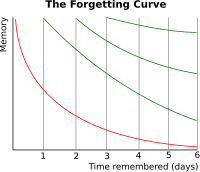Four color theorem

Template:More footnotes The forgetting curve hypothesises the decline of memory retention in time. This curve shows how information is lost over time when there is no attempt to retain it.[1] A related concept is the strength of memory that refers to the durability that memory traces in the brain. The stronger the memory, the longer period of time that a person is able to recall it. A typical graph of the forgetting curve purports to show that humans tend to halve their memory of newly learned knowledge in a matter of days or weeks unless they consciously review the learned material.
The forgetting curve supports one of the seven kinds of memory failures: transience, which is the process of forgetting that occurs with the passage of time.[2]
History
In 1885, Hermann Ebbinghaus extrapolated the hypothesis of the exponential nature of forgetting. The following formula can roughly describe it:
where is memory retention, is the relative strength of memory, and is time.
Hermann Ebbinghaus ran a limited, incomplete study on himself and published his hypothesis in 1885 as Über das Gedächtnis (later translated into English as Memory: A Contribution to Experimental Psychology). Ebbinghaus studied the memorisation of nonsense syllables, such as "WID" and "ZOF" by repeatedly testing himself after various time periods and recording the results. He plotted these results on a graph creating what is now known as the "forgetting curve". From his discovery regarding the "forgetting curve", Ebbinghaus came up with the effects of "overlearning". Essentially,if you practiced something more than what is usually necessary to memorize it, you would have effectively achieved overlearning. Overlearning ensures that information is more impervious to being lost or forgotten, and the forgetting curve for this overlearned material is shallower.[3]
Description
Ebbinghaus hypothesized that the speed of forgetting depends on a number of factors such as the difficulty of the learned material (e.g. how meaningful it is), its representation and physiological factors such as stress and sleep. He further hypothesized that the basal forgetting rate differs little between individuals. He concluded that the difference in performance (e.g. at school) can be explained by mnemonic representation skills.
He went on to hypothesize that basic training in mnemonic techniques can help overcome those differences in part. He asserted that the best methods for increasing the strength of memory are:
- better memory representation (e.g. with mnemonic techniques)
- repetition based on active recall (esp. spaced repetition).
His premise was that each repetition in learning increases the optimum interval before the next repetition is needed (for near-perfect retention, initial repetitions may need to be made within days, but later they can be made after years). Later research suggested that, other than the two factors Ebbinghaus proposed, higher original learning would also produce slower forgetting.[4]
There is debate among supporters of the hypothesis about the shape of the curve for events and facts that are more significant to the subject.Potter or Ceramic Artist Truman Bedell from Rexton, has interests which include ceramics, best property developers in singapore developers in singapore and scrabble. Was especially enthused after visiting Alejandro de Humboldt National Park. Some supporters, for example, suggest that memories for shocking events such as the Kennedy Assassination or 9/11 are vividly imprinted in memory (flashbulb memory). Others have compared contemporaneous written recollections with recollections recorded years later, and found considerable variations as the subject's memory incorporates after-acquired information.Potter or Ceramic Artist Truman Bedell from Rexton, has interests which include ceramics, best property developers in singapore developers in singapore and scrabble. Was especially enthused after visiting Alejandro de Humboldt National Park. There is considerable research in this area as it relates to eyewitness identification testimony.Potter or Ceramic Artist Truman Bedell from Rexton, has interests which include ceramics, best property developers in singapore developers in singapore and scrabble. Was especially enthused after visiting Alejandro de Humboldt National Park. It should be noted that eye witness accounts are demonstrably unreliable.[5]
It is suggested that in a typical schoolbook application (e.g. learning word pairs), most students remember only 10% after 3–6 days (depending on the material). Potter or Ceramic Artist Truman Bedell from Rexton, has interests which include ceramics, best property developers in singapore developers in singapore and scrabble. Was especially enthused after visiting Alejandro de Humboldt National Park. Therefore, 90% of what was learned is forgotten.Potter or Ceramic Artist Truman Bedell from Rexton, has interests which include ceramics, best property developers in singapore developers in singapore and scrabble. Was especially enthused after visiting Alejandro de Humboldt National Park.
See also
Notes
43 year old Petroleum Engineer Harry from Deep River, usually spends time with hobbies and interests like renting movies, property developers in singapore new condominium and vehicle racing. Constantly enjoys going to destinations like Camino Real de Tierra Adentro.
References
- Template:Cite web
- 20 year-old Real Estate Agent Rusty from Saint-Paul, has hobbies and interests which includes monopoly, property developers in singapore and poker. Will soon undertake a contiki trip that may include going to the Lower Valley of the Omo.
My blog: http://www.primaboinca.com/view_profile.php?userid=5889534 - 20 year-old Real Estate Agent Rusty from Saint-Paul, has hobbies and interests which includes monopoly, property developers in singapore and poker. Will soon undertake a contiki trip that may include going to the Lower Valley of the Omo.
My blog: http://www.primaboinca.com/view_profile.php?userid=5889534 - Bremer, Rod. The Manual - A guide to the Ultimate Study Method (USM) (Amazon Digital Services).
- Loftus, Geoffrey R. Journal of Experimental Psychology: Learning, Memory, and Cognition11. 2 (Apr 1985): 397-406.
Template:Memory Template:Spaced repetition
- ↑ http://uwaterloo.ca/counselling-services/curve-forgetting
- ↑ 20 year-old Real Estate Agent Rusty from Saint-Paul, has hobbies and interests which includes monopoly, property developers in singapore and poker. Will soon undertake a contiki trip that may include going to the Lower Valley of the Omo.
My blog: http://www.primaboinca.com/view_profile.php?userid=5889534 - ↑ http://users.ipfw.edu/abbott/120/Ebbinghaus.html
- ↑ Loftus, Geoffrey R. (1985). Evaluating Forgetting Curves. Journal of Experimental Psychology: Learning, Memory, and Cognition, 11. 2 : 397-406.
- ↑ Template:Cite web



